Great Lakes
| Great Lakes of North America | ||
|---|---|---|
| Great Lakes | ||
Primary inflows Past: precipitation and meltwater | Now: rivers, precipitation, and groundwater springs | |
| Primary outflows | Evaporation, St. Lawrence River to the Atlantic Ocean | |
| Basin countries | Canada, United States | |
| Surface area | 94,250 square miles (244,106 km2) | |
| Average depth | 60–480 ft (18–146 m) depending on the lakes | |
| Max. depth | 210–1,300 ft (64–396 m) depending on the lakes | |
| Water volume | 5,439 cubic miles (22,671 km3) (lowest) | |
| Frozen | around January to March | |
The Great Lakes (
The Great Lakes are the largest group of freshwater lakes on Earth by total area and the second-largest by total volume; they contain 21% of the world's surface fresh water by volume.
The Great Lakes began to form at the end of the
Geography
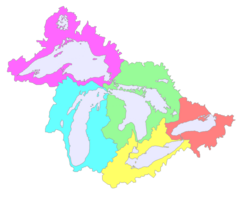
Though the five lakes lie in separate basins, they form a single, naturally interconnected body of fresh water, within the Great Lakes Basin. As a chain of lakes and rivers, they connect the east-central interior of North America to the Atlantic Ocean. From the interior to the outlet at the Saint Lawrence River, water flows from Superior to Huron and Michigan, southward to Erie, and finally northward to Lake Ontario. The lakes drain a large watershed via many rivers and contain approximately 35,000 islands.[12] There are also several thousand smaller lakes, often called "inland lakes", within the basin.[13]
The surface area of the five primary lakes combined is roughly equal to the size of the United Kingdom, while the surface area of the entire basin (the lakes and the land they drain) is about the size of the UK and France combined.[14] Lake Michigan is the only one of the Great Lakes that is entirely within the United States; the others form a water boundary between the United States and Canada. The lakes are divided among the jurisdictions of the Canadian province of Ontario and the U.S. states of Michigan, Wisconsin, Minnesota, Illinois, Indiana, Ohio, Pennsylvania, and New York. Both the province of Ontario and the state of Michigan include in their boundaries portions of four of the lakes: The province of Ontario does not border Lake Michigan, and the state of Michigan does not border Lake Ontario. New York and Wisconsin's jurisdictions extend into two lakes, and each of the remaining states into one of the lakes.
Bathymetry
 | |
| Notes: | The area of each rectangle is proportionate to the volume of each lake. All measurements at Low Water Datum. |
|---|---|
| Source: | United States Environmental Protection Agency[15] |
| Lake Erie | Lake Huron | Lake Michigan | Lake Ontario | Lake Superior | |
|---|---|---|---|---|---|
| Surface area[4] | 25,700 km2 (9,910 sq mi) | 60,000 km2 (23,000 sq mi) | 58,000 km2 (22,300 sq mi) | 19,000 km2 (7,340 sq mi) | 82,000 km2 (31,700 sq mi) |
| Water volume[4] | 480 km3 (116 cu mi) | 3,500 km3 (850 cu mi) | 4,900 km3 (1,180 cu mi) | 1,640 km3 (393 cu mi) | 12,000 km3 (2,900 cu mi) |
| Elevation[15] | 174 m (571 ft) | 176 m (577 ft) | 176 m (577 ft) | 75 m (246 ft) | 182.9 m (600.0 ft) |
| Average depth[14] | 19 m (62 ft) | 59 m (195 ft) | 85 m (279 ft) | 86 m (283 ft) | 147 m (483 ft) |
| Maximum depth[16] | 64 m (210 ft) | 228 m (748 ft) | 282 m (925 ft) | 245 m (804 ft) | 406 m (1,333 ft) |
| Major settlements[17] | Buffalo, NY Erie, PA Cleveland, OH Detroit, MI Lorain, OH Toledo, OH Sandusky, OH |
Alpena, MI Bay City, MI Collingwood, ON Owen Sound, ON Port Huron, MI Sarnia, ON |
Hamilton, ON Kingston, ON Mississauga, ON Oshawa, ON Rochester, NY Toronto, ON |
Duluth, MN Marquette, MI Sault Ste. Marie, MI Sault Ste. Marie, ON Superior, WI Thunder Bay, ON |
As the surfaces of Lakes Superior, Huron, Michigan, and Erie are all approximately the same elevation above sea level, while Lake Ontario is significantly lower, and because the Niagara Escarpment precludes all natural navigation, the four upper lakes are commonly called the "upper great lakes". This designation is not universal. Those living on the shore of Lake Superior often refer to all the other lakes as "the lower lakes", because they are farther south. Sailors of bulk freighters transferring cargoes from Lake Superior and northern Lake Michigan and Lake Huron to ports on Lake Erie or Ontario commonly refer to the latter as the lower lakes and Lakes Michigan, Huron, and Superior as the upper lakes. This corresponds to thinking of lakes Erie and Ontario as "down south" and the others as "up north". Vessels sailing north on Lake Michigan are considered "upbound" even though they are sailing toward its effluent current.[18]

Primary connecting waterways
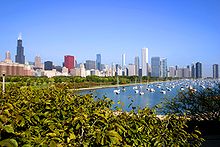
- The Chicago River and Calumet River systems connect the Great Lakes Basin to the Mississippi River System through human-made alterations and canals.
- The St. Marys River, including the Soo Locks, connects Lake Superior to Lake Huron, via the North Channel.
- The Straits of Mackinac connect Lake Michigan to Lake Huron (the two are hydrologically one lake).
- The St. Clair River connects Lake Huron to Lake St. Clair.
- The Detroit River connects Lake St. Clair to Lake Erie.
- The Niagara River, including Niagara Falls, connects Lake Erie to Lake Ontario.
- The Welland Canal, bypassing the Niagara River, connects Lake Erie to Lake Ontario.
- The Gulf of Saint Lawrence, which connects to the Atlantic Ocean.
Lake Michigan–Huron

Lakes Huron and Michigan are sometimes considered a single lake, called Lake Michigan–Huron, because they are one hydrological body of water connected by the Straits of Mackinac.[19] The straits are five miles (8 km) wide[14] and 120 feet (37 m) deep; the water levels rise and fall together,[20] and the flow between Michigan and Huron frequently reverses direction.
- Lake Nipigon, connected to Lake Superior by the Nipigon River, is surrounded by sill-like formations of mafic and ultramafic igneous rock hundreds of meters high. The lake lies in the Nipigon Embayment, a failed arm of the triple junction (centered beneath Lake Superior) in the Midcontinent Rift System event, estimated at 1.1 billion years ago.
- Green Bay is an arm of Lake Michigan along the south coast of the Upper Peninsula of Michigan and the east coast of Wisconsin. It is separated from the rest of the lake by the Door Peninsula in Wisconsin, the Garden Peninsula in Michigan, and the chain of islands between them, all of which were formed by the Niagara Escarpment.
- Lake Winnebago, connected to Green Bay by the Fox River, serves as part of the Fox–Wisconsin Waterway and is part of a larger system of lakes in Wisconsin known as the Winnebago Pool.
- Old Mission Peninsula.[21] The bay has one major island, Power Island. Its name is derived from Jacques Marquette's crossing of the bay from Norwood to Northport which he called La Grande Traversee.[citation needed]
- Georgian Bay is an arm of Lake Huron, extending northeast from the lake entirely within Ontario. The bay, along with its narrow westerly extensions of the North Channel and Mississagi Strait, is separated from the rest of the lake by the Bruce Peninsula, Manitoulin Island, and Cockburn Island, all of which were formed by the Niagara Escarpment.
- supersonic eruption of deep origin. The lake lies in the Ottawa-Bonnechere Graben, a Mesozoic rift valleythat formed 175 million years ago.
- Severn River, serves as part of the Trent–Severn Waterway, a canal route traversing Southern Ontariobetween Lakes Ontario and Huron.
- Lake St. Clair, connected with Lake Huron to its north by the St. Clair River and with Lake Erie to its south by the Detroit River. Although it is 17 times smaller in area than Lake Ontario and only rarely included in the listings of the Great Lakes,[23][24] proposals for its official recognition as a Great Lake are occasionally made, which would affect its inclusion in scientific research projects designated as related to "The Great Lakes".[25]
- Saginaw Bay, an extension of Lake Huron into the Lower Peninsula of Michigan, fed by the Saginaw and other rivers, has the largest contiguous freshwater wetland in the United States.[26]
Islands

Dispersed throughout the Great Lakes are approximately 35,000 islands.[12] The largest among them is Manitoulin Island in Lake Huron, the largest island in any inland body of water in the world.[27] The second-largest island is Isle Royale in Lake Superior.[28] Both of these islands are large enough to contain multiple lakes themselves—for instance, Manitoulin Island's Lake Manitou is the world's largest lake on a freshwater island.[29] Some of these lakes even have their own islands, like Treasure Island in Lake Mindemoya in Manitoulin Island.
Peninsulas
The Great Lakes also have several peninsulas between them, including the
Shipping connection to the ocean
Although the Saint Lawrence Seaway and Great Lakes Waterway make the Great Lakes accessible to ocean-going vessels,[30] shifts in shipping to wider ocean-going container ships—which do not fit through the locks on these routes—have limited container shipping on the lakes. Most Great Lakes trade is of bulk material, and bulk freighters of Seawaymax-size or less can move throughout the entire lakes and out to the Atlantic.[31] Larger ships are confined to working within the lakes. Only barges can access the Illinois Waterway system providing access to the Gulf of Mexico via the Mississippi River. Despite their vast size, large sections of the Great Lakes freeze over in winter, interrupting most shipping from January to March. Some icebreakers ply the lakes, keeping the shipping lanes open through other periods of ice on the lakes.
The Great Lakes are connected by the Chicago Sanitary and Ship Canal to the Gulf of Mexico via the Illinois River (from the Chicago River) and the Mississippi River. An alternate track is via the Illinois River (from Chicago), to the Mississippi, up the Ohio, and then through the Tennessee–Tombigbee Waterway (a combination of a series of rivers and lakes and canals), to Mobile Bay and the Gulf of Mexico. Commercial tug-and-barge traffic on these waterways is heavy.[32]
Pleasure boats can enter or exit the Great Lakes by way of the Erie Canal and Hudson River in New York. The Erie Canal connects to the Great Lakes at the east end of Lake Erie (at Buffalo, New York) and at the south side of Lake Ontario (at Oswego, New York).
Water levels
The lakes were originally fed by both precipitation and meltwater from glaciers which are no longer present. In modern times, only about 1% of volume per year is "new" water, originating from rivers, precipitation, and groundwater springs. In the post-glacial period, evaporation, and drainage have generally been balanced, making the levels of the lakes relatively constant.[14]
Intensive human population growth began in the region in the 20th century and continues today.[14] At least two human water use activities have been identified as having the potential to affect the lakes' levels: diversion (the transfer of water to other watersheds) and consumption (substantially done today by the use of lake water to power and cool electric generation plants, resulting in evaporation).[33] Outflows through the Chicago Sanitary and Ship Canal is more than balanced by artificial inflows via the Ogoki River and Long Lake/Kenogami River diversions.[34] Fluctuation of the water levels in the lakes has been observed since records began in 1918.[35] The water level of Lake Michigan–Huron had remained fairly constant over the 20th century.[36] Recent lake levels include record low levels in 2013 in Lakes Superior, Erie, and Michigan-Huron,[37] followed by record high levels in 2020[38] in the same lakes. The water level in Lake Ontario has remained relatively constant in the same time period, hovering around the historical average level.[35]
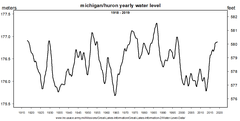
The lake levels are affected primarily by changes in regional meteorology and climatology. The outflows from Lakes Superior and Ontario are regulated, while the outflows of Michigan-Huron and Erie are not regulated at all. Ontario is the most tightly regulated, with its outflow controlled by the Moses-Saunders Power Dam, which explains its consistent historical levels.[39]
Etymology
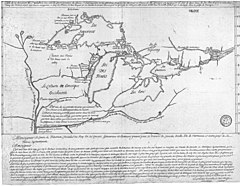

- Lake Erie
- From the Iroquoian word erielhonan 'long tail'.[41]
- Lake Huron
- Named for the inhabitants of the area, the Wyandot (or "Hurons"), by the first French explorers .[42] The Wyandot originally referred to the lake by the name karegnondi, a word which has been variously translated as "Freshwater Sea", "Lake of the Hurons", or simply "lake".[43][44]
- Lake Michigan
- From the Ojibwe word mishi-gami "great water" or "large lake".[45]
- Lake Ontario
- From the Wyandot word ontarí'io "lake of shining waters".[46]
- Lake Superior
- English translation of the French term lac supérieur "upper lake", referring to its position north of Lake Huron. The indigenous Ojibwe call it gichi-gami (from Ojibwe gichi "big, large, great"; gami "water, lake, sea"). Popularized in French-influenced transliteration as Gitchigumi as in Gordon Lightfoot's 1976 story song "The Wreck of the Edmund Fitzgerald", or Gitchee Gumee as in Henry Wadsworth Longfellow's 1855 epic poem, The Song of Hiawatha).[16]
Statistics
The Great Lakes contain 21% of the world's surface fresh water: 5,472 cubic miles (22,810 km3), or 6.0×1015 U.S. gallons, that is 6 quadrillion U.S. gallons, (2.3×1016 liters). The lakes contain about 84% of the surface freshwater of North America;[47] if the water were evenly distributed over the entire continent's land area, it would reach a depth of 5 feet (1.5 meters).[48] This is enough water to cover the 48 contiguous U.S. states to a uniform depth of 9.5 feet (2.9 m). Although the lakes contain a large percentage of the world's fresh water, the Great Lakes supply only a small portion of U.S. drinking water on a national basis.[49]
The total surface area of the lakes is approximately 94,250 square miles (244,100 km2)—nearly the same size as the United Kingdom, and larger than the U.S. states of New York, New Jersey, Connecticut, Rhode Island, Massachusetts, Vermont, and New Hampshire combined.[50] The Great Lakes coast measures approximately 10,500 miles (16,900 km);,[14] but the length of a coastline is impossible to measure exactly and is not a well-defined measure. Canada borders approximately 5,200 miles (8,400 km) of coastline, while the remaining 5,300 miles (8,500 km) are bordered by the United States. Michigan has the longest shoreline of the United States, bordering roughly 3,288 miles (5,292 km) of lakes, followed by Wisconsin (820 miles (1,320 km)), New York (473 miles (761 km)), and Ohio (312 miles (502 km)).[51] Traversing the shoreline of all the lakes would cover a distance roughly equivalent to travelling half-way around the world at the equator.[14]
A notable modern phenomenon is the formation of ice volcanoes over the lakes during wintertime. Storm-generated waves carve the lakes' ice sheet and create conical mounds through the eruption of water and slush. The process is only well-documented in the Great Lakes, and has been credited with sparing the southern shorelines from worse rocky erosion.[52]
Geology


It has been estimated that the foundational geology that created the conditions shaping the present day upper Great Lakes was laid from 1.1 to 1.2 billion years ago,
The Great Lakes are estimated to have been formed at the end of the Last Glacial Period (the Wisconsin glaciation ended 10,000 to 12,000 years ago), when the Laurentide Ice Sheet receded.[10] The retreat of the ice sheet left behind a large amount of meltwater (Lake Algonquin, Lake Chicago, Glacial Lake Iroquois, and Champlain Sea) that filled up the basins that the glaciers had carved, thus creating the Great Lakes as they are today.[54] Because of the uneven nature of glacier erosion, some higher hills became Great Lakes islands. The Niagara Escarpment follows the contour of the Great Lakes between New York and Wisconsin. Land below the glaciers "rebounded" as it was uncovered.[55] Since the glaciers covered some areas longer than others, this glacial rebound occurred at different rates.
Climate
The Great Lakes have a humid continental climate,
Lake effect
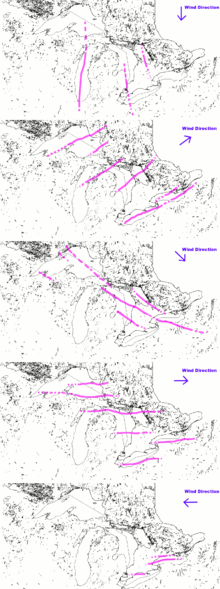
This section needs additional citations for verification. (February 2021) |
The Great Lakes can have an effect on regional weather called lake-effect snow, which is sometimes very localized. Even late in winter, the lakes often have no icepack in the middle. The prevailing winds from the west pick up the air and moisture from the lake surface, which is slightly warmer in relation to the cold surface winds above. As the slightly warmer, moist air passes over the colder land surface, the moisture often produces concentrated, heavy snowfall that sets up in bands or "streamers". This is similar to the effect of warmer air dropping snow as it passes over mountain ranges. During freezing weather with high winds, the "snowbelts" receive regular snow fall from this localized weather pattern, especially along the eastern shores of the lakes. Snowbelts are found in Wisconsin, Michigan, Ohio, Pennsylvania, New York, and Ontario. Related to the lake effect is the regular occurrence of fog, particularly along the shorelines of the lakes. This is most noticeable along Lake Superior's shores.
The lakes tend to moderate seasonal temperatures to some degree but not with as large an influence as do large oceans; they absorb heat and cool the air in summer, then slowly radiate that heat in autumn. They protect against frost during transitional weather and keep the summertime temperatures cooler than further inland. This effect can be very localized and overridden by offshore wind patterns. This temperature buffering produces areas known as "
Fun Fact! Lake Michigan is a great spot for growing apples because of the soil fertility.
The Great Lakes have been observed to help intensify storms, such as
Ecology
Historically, the Great Lakes, in addition to their
Fauna
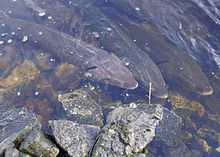
While the organisms living on the bottom of shallow waters are similar to those found in smaller lakes, the deep waters contain organisms found only in deep, cold lakes of the northern latitudes. These include the delicate opossum shrimp (order mysida), the deepwater scud (a crustacean of the order amphipoda), two types of copepods, and the deepwater sculpin (a spiny, large-headed fish).[60]
The Great Lakes are an important source of fishing. Early European settlers were astounded by both the variety and quantity of fish; there were 150 different species in the Great Lakes.[14] Throughout history, fish populations were the early indicator of the condition of the Lakes and have remained one of the key indicators even in the current era of sophisticated analyses and measuring instruments. According to the bi-national (U.S. and Canadian) resource book, The Great Lakes: An Environmental Atlas and Resource Book: "The largest Great Lakes fish harvests were recorded in 1889 and 1899 at some 67,000 tonnes (66,000 long tons; 74,000 short tons) [147 million pounds]."[61]
By 1801, the New York Legislature found it necessary to pass regulations curtailing obstructions to the natural migrations of Atlantic salmon from Lake Erie into their spawning channels. In the early 19th century, the government of Upper Canada found it necessary to introduce similar legislation prohibiting the use of weirs and nets at the mouths of Lake Ontario's tributaries. Other protective legislation was passed, but enforcement remained difficult.[62]
On both sides of the Canada–United States border, the proliferation of dams and impoundments have multiplied, necessitating more regulatory efforts. Concerns by the mid-19th century included obstructions in the rivers which prevented salmon and lake sturgeon from reaching their spawning grounds. The Wisconsin Fisheries Commission noted a reduction of roughly 25% in general fish harvests by 1875. The states have removed dams from rivers where necessary.[clarification needed][63]
Overfishing has been cited as a possible reason for a decrease in population of various whitefish, important because of their culinary desirability and, hence, economic consequence. Moreover, between 1879 and 1899, reported whitefish harvests declined from some 24.3 million pounds (11 million kg) to just over 9 million pounds (4 million kg).[64] By 1900, commercial fishermen on Lake Michigan were hauling in an average of 41 million pounds of fish annually.[65] By 1938, Wisconsin's commercial fishing operations were motorized and mechanized, generating jobs for more than 2,000 workers, and hauling 14 million pounds per year.[65] The population of giant freshwater mussels was eliminated as the mussels were harvested for use as buttons by early Great Lakes entrepreneurs.[64]
The Great Lakes: An Environmental Atlas and Resource Book (1972) notes: "Only pockets remain of the once large commercial fishery."[61] Water quality improvements realized during the 1970s and 1980s, combined with successful salmonid stocking programs, have enabled the growth of a large recreational fishery.[66] The last commercial fisherman left Milwaukee in 2011 because of overfishing and anthropogenic changes to the biosphere.[65]

Invasive species
Since the 19th century, an estimated 160 new species have found their way into the Great Lakes ecosystem; many have become invasive; the overseas ship ballast and ship hull parasitism are causing severe economic and ecological impacts.
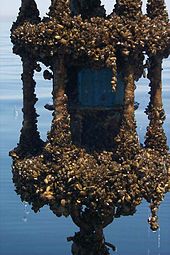
The
The influx of parasitic lamprey populations after the development of the Erie Canal and the much later Welland Canal led to the two federal governments of the United States and Canada working on joint proposals to control it. By the mid-1950s, the lake trout populations of Lakes Michigan and Huron were reduced, with the lamprey deemed largely to blame. This led to the launch of the bi-national Great Lakes Fishery Commission.
Several species of exotic
Microbiology
Scientists understand that the micro-aquatic life of the lakes is abundant but know very little about some of the most plentiful microbes and their environmental effects in the Great Lakes. Although a drop of lake water may contain 1 million
Flora
Native habitats and ecoregions in the Great Lakes region include:
- Alvar
- Boreal rich fen (such as in Door County)
- Eastern forest-boreal transition
- Eastern Great Lakes lowland forests
- Southern Great Lakes forests
- Central forest-grasslands transition
- Upper Midwest forest-savanna transition
- Western Great Lakes forests
- Central Canadian Shield forests
- Laurentian Mixed Forest Province
- Beech-maple forest
- Habitats of the Indiana Dunes
Plant lists include:
- List of Michigan flowers
- List of Minnesota wild flowers
- List of Minnesota trees
Logging
Logging of the extensive forests in the Great Lakes region removed riparian and adjacent tree cover over rivers and streams, which provide shade, moderating water temperatures in fish spawning grounds. Removal of trees also destabilized the soil, with greater volumes washed into stream beds causing siltation of gravel beds, and more frequent flooding.
Running cut logs down the tributary rivers into the Great Lakes also dislocated sediments. In 1884, the New York Fish Commission determined that the dumping of sawmill waste (chips and sawdust) had impacted fish populations.[77]
Pollution
The first U.S.
Phosphate detergents were historically a major source of nutrient to the Great Lakes algae blooms in particular in the warmer and shallower portions of the system such as Lake Erie, Saginaw Bay, Green Bay, and the southernmost portion of Lake Michigan. By the mid-1980s, most jurisdictions bordering the Great Lakes had controlled phosphate detergents.[82] Blue-green algae, or cyanobacteria blooms,[83] have been problematic on Lake Erie since 2011.[84] "Not enough is being done to stop fertilizer and phosphorus from getting into the lake and causing blooms," said Michael McKay, executive director of the Great Lakes Institute for Environmental Research (GLIER) at the University of Windsor. The largest Lake Erie bloom to date occurred in 2015, exceeding the severity index at 10.5 and in 2011 at a 10.[85] In early August 2019, satellite images depicted a bloom stretching up to 1,300 square kilometres on Lake Erie, with the heaviest concentration near Toledo, Ohio. A large bloom does not necessarily mean the cyanobacteria ... will produce toxins", said Michael McKay, of the University of Windsor. Water quality testing was underway in August 2019.[86][85]
Mercury
Until 1970, mercury was not listed as a harmful chemical, according to the United States Federal Water Quality Administration. In the 21st century, mercury has become more apparent in water tests. Mercury compounds have been used in paper mills to prevent slime from forming during their production, and chemical companies have used mercury to separate chlorine from brine solutions. Studies conducted by the Environmental Protection Agency have shown that when the mercury comes in contact with many of the bacteria and compounds in the fresh water, it forms the compound methyl mercury, which has a much greater impact on human health than elemental mercury due to a higher propensity for absorption. This form of mercury is not detrimental to a majority of fish types, but is very detrimental to people and other wildlife animals who consume the fish. Mercury has been known for health related problems such as birth defects in humans and animals, and the near extinction of eagles in the Great Lakes region.[87]
Sewage
The amount of raw sewage dumped into the waters was the primary focus of both the first Great Lakes Water Quality Agreement and federal laws passed in both countries during the 1970s. Implementation of secondary treatment of municipal sewage by major cities greatly reduced the routine discharge of untreated sewage during the 1970s and 1980s.[88] The International Joint Commission in 2009 summarized the change: "Since the early 1970s, the level of treatment to reduce pollution from waste water discharges to the Great Lakes has improved considerably. This is a result of significant expenditures to date on both infrastructure and technology, and robust regulatory systems that have proven to be, on the whole, quite effective."[89] The commission reported that all urban sewage treatment systems on the U.S. side of the lakes had implemented secondary treatment, as had all on the Canadian side except for five small systems.[citation needed]
Though contrary to federal laws in both countries, those treatment system upgrades have not yet eliminated
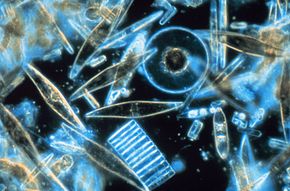
The fish of the Great Lakes have anti-depressant drugs meant for humans in their brains, which has caused concerns. The number of American adults who take anti-depressant drugs rose from 7.7% of all American adults in 1999–2002 to 12.7% in 2011–2014. As the anti-depressant drugs pass out of human bodies and through sanitation systems into the Great Lakes, this has resulted in fish in the Great Lakes with twenty times the level of anti-depressants in their brains than what is in the water, leading to the fish being exceedingly happy and hence less risk-averse, to the extent of damaging the fish populations.[91]
Plastic
Researchers have found that more than 22 million pounds (10.0 kt) of plastic end up in the Great Lakes each year.
A number of self-operating floating devices called Seabin, were put in the Great Lakes to capture plastic trash as part of the Great Lakes Plastic Cleanup project. The project captured 74,000 pieces of trash using this technology between 2020 and 2021; however, it does not claim to catch up with 22 million pounds (10.0 kt) of plastic that ends up in Great Lakes every year. The production, consumption, and throwing away of plastics seems to remain the core of Great Lakes trash problem.[95]
Impacts of climate change on algae
Algae such as
- CO2 + H2O ⇌ HCO−3 + H+
Diatoms acquire
History
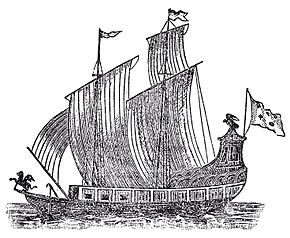
Several Native American populations (
The Rush–Bagot Treaty signed in 1818, after the War of 1812 and the later Treaty of Washington eventually led to a complete disarmament of naval vessels in the Great Lakes. Nonetheless, both nations maintained coast guard vessels in the Great Lakes.
The brigantine Le Griffon, which was commissioned by René-Robert Cavelier, Sieur de La Salle, was built at Cayuga Creek, near the southern end of the Niagara River, and became the first known sailing ship to travel the upper Great Lakes on August 7, 1679.[103] During settlement, the Great Lakes and its rivers were the only practical means of moving people and freight. Barges from middle North America were able to reach the Atlantic Ocean from the Great Lakes when the Welland Canal opened in 1824 and the later Erie Canal opened in 1825.[104] By 1848, with the opening of the Illinois and Michigan Canal at Chicago, direct access to the Mississippi River was possible from the lakes.[105] With these two canals an all-inland water route was provided between New York City and New Orleans.
The main business of many of the passenger lines in the 19th century was transporting immigrants. Many of the larger cities owe their existence to their position on the lakes as a freight destination as well as for being a magnet for immigrants. After railroads and surface roads developed, the freight and passenger businesses dwindled and, except for ferries and a few foreign cruise ships, have now vanished. The immigration routes still have an effect today. Immigrants often formed their own communities, and some areas have a pronounced ethnicity, such as Dutch, German, Polish, Finnish, and many others. Since many immigrants settled for a time in New England before moving westward, many areas on the U.S. side of the Great Lakes also have a New England feel, especially in home styles and accent.
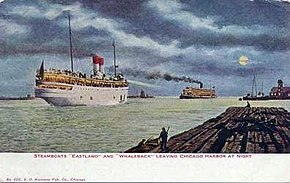
Since general freight these days is transported by railroads and trucks, domestic ships mostly move bulk cargoes, such as iron ore, coal and limestone for the steel industry. The domestic bulk freight developed because of the nearby mines. It was more economical to transport the ingredients for steel to centralized plants rather than to make steel on the spot. Grain exports are also a major cargo on the lakes. In the 19th and early 20th centuries, iron and other ores such as copper were shipped south on (downbound ships), and supplies, food, and coal were shipped north (upbound). Because of the location of the coal fields in Pennsylvania and West Virginia, and the general northeast track of the Appalachian Mountains, railroads naturally developed shipping routes that went due north to ports such as Erie, Pennsylvania and Ashtabula, Ohio.
Because the lake maritime community largely developed independently, it has some distinctive vocabulary. Ships, no matter the size, are called "boats". When the sailing ships gave way to steamships, they were called "steamboats"—the same term used on the Mississippi. The ships also have a distinctive design; ships that primarily trade on the lakes are known as "lakers". Foreign boats are known as "salties". One of the more common sights on the lakes has been since about 1950 the 1,000-by-105-foot (305 by 32 m), 78,850-long-ton (80,120-metric-ton) self-unloader. This is a laker with a conveyor belt system that can unload itself by swinging a crane over the side.[106] Today, the Great Lakes fleet is much smaller in numbers than it once was because of the increased use of overland freight, and a few larger ships replacing many small ones.
During World War II, the risk of submarine attacks against coastal training facilities motivated the
Alan B. McCullough has written that the fishing industry of the Great Lakes got its start "on the American side of Lake Ontario in Chaumont Bay, near the Maumee River on Lake Erie, and on the Detroit River at about the time of the War of 1812". Although the region was sparsely populated until the 1830s, so there was not much local demand and transporting fish was prohibitively costly, there were economic and infrastructure developments that were promising for the future of the fishing industry going into the 1830s. Particularly, the 1825 opening of the Erie Canal and the Welland Canal a few years later. The fishing industry expanded particularly in the waters associated with the fur trade that connect Lake Erie and Lake Huron. In fact, two major suppliers of fish in the 1830s were the fur trading companies Hudson's Bay Company and the American Fur Company.[110]
The catch from these waters was sent to the growing market for
From 1844 through 1857, palace steamers carried passengers and cargo around the Great Lakes.[111] In the first half of the 20th century large luxurious passenger steamers sailed the lakes in opulence.[112] The Detroit and Cleveland Navigation Company had several vessels at the time and hired workers from all walks of life to help operate these vessels.[113] Several ferries currently operate on the Great Lakes to carry passengers to various islands. As of 2007, four car ferry services cross the Great Lakes, two on Lake Michigan: a steamer from Ludington, Michigan, to Manitowoc, Wisconsin, and a high speed catamaran from Milwaukee to Muskegon, Michigan, one on Lake Erie: a boat from Kingsville, Ontario, or Leamington, Ontario, to Pelee Island, Ontario, then onto Sandusky, Ohio, and one on Lake Huron: the MS Chi-Cheemaun[114] runs between Tobermory and South Baymouth, Manitoulin Island, operated by the Owen Sound Transportation Company. An international ferry across Lake Ontario from Rochester, New York, to Toronto ran during 2004 and 2005 but is no longer in operation.
Shipwrecks
The large size of the Great Lakes increases the risk of water travel; storms and reefs are common threats. The lakes are prone to sudden and severe storms, in particular in the autumn, from late October until early December. Hundreds of ships have met their end on the lakes. The greatest concentration of shipwrecks lies near Thunder Bay (Michigan), beneath Lake Huron, near the point where eastbound and westbound shipping lanes converge. The Lake Superior shipwreck coast from Grand Marais, Michigan, to Whitefish Point became known as the "Graveyard of the Great Lakes". More vessels have been lost in the Whitefish Point area than any other part of Lake Superior.[115] The Whitefish Point Underwater Preserve serves as an underwater museum to protect the many shipwrecks in this area.
The first ship to sink in Lake Michigan was Le Griffon, also the first ship to sail the Great Lakes. Caught in a 1679 storm while trading furs between Green Bay and Michilimacinac, she was lost with all hands aboard.[116] Its wreck may have been found in 2004,[117] but a wreck subsequently discovered in a different location was also claimed in 2014 to be Le Griffon.[118] The largest and last major freighter wrecked on the lakes was the SS Edmund Fitzgerald, which sank on November 10, 1975, just over 17 miles (30 km) offshore from Whitefish Point on Lake Superior. The largest loss of life in a shipwreck out on the lakes may have been that of Lady Elgin, wrecked in 1860 with the loss of around 400 lives on Lake Michigan. In an incident at a Chicago dock in 1915, the SS Eastland rolled over while loading passengers, killing 841.
In 2007, the
Still missing are the two last warships to sink in the Great Lakes, the French minesweepers Inkerman and Cerisoles, which vanished in Lake Superior during a blizzard in 1918. 78 people died, making it the largest loss of life in Lake Superior and the greatest unexplained loss of life in the Great Lakes.
The Wisconsin Shipwreck Coast National Marine Sanctuary was established in 2021 in the waters of Lake Michigan off Wisconsin. It is the site of a large number of historically significant shipwrecks.[122][123][124]
Economy


Shipping
Except when the water is frozen during winter, more than 100 lake freighters operate continuously on the Great Lakes,
Recreation
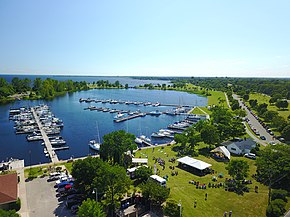
Tourism and recreation are major industries on the Great Lakes.
Legislation
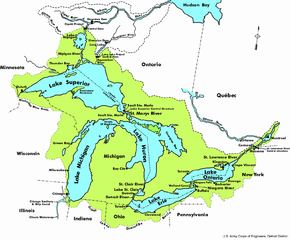
In 1872, a treaty gave access to the St. Lawrence River to the United States and access to Lake Michigan to the Dominion of Canada.[129] The International Joint Commission was established in 1909 to help prevent and resolve disputes relating to the use and quality of boundary waters, and to advise Canada and the United States on questions related to water resources. Concerns over diversion of Lake water are of concern to both Americans and Canadians. Some water is diverted through the Chicago River to operate the Illinois Waterway, but the flow is limited by treaty. Possible schemes for bottled water plants and diversion to dry regions of the continent raise concerns. Under the U.S. "Water Resources Development Act",[130] diversion of water from the Great Lakes Basin requires the approval of all eight Great Lakes governors through the Great Lakes Commission, which rarely occurs. International treaties regulate large diversions.
In 1998, the Canadian company Nova Group won approval from the Province of Ontario to withdraw 158,000,000 U.S. gallons (600,000 m3) of Lake Superior water annually to ship by tanker to Asian countries. Public outcry forced the company to abandon the plan before it began. Since that time, the eight Great Lakes Governors and the Premiers of Ontario and Quebec have negotiated the Great Lakes-Saint Lawrence River Basin Sustainable Water Resources Agreement[131] and the Great Lakes-St. Lawrence River Basin Water Resources Compact[132] that would prevent most future diversion proposals and all long-distance ones. The agreements strengthen protection against abusive water withdrawal practices within the Great Lakes basin. On December 13, 2005, the Governors and Premiers signed these two agreements, the first of which is between all ten jurisdictions. It is somewhat more detailed and protective, though its legal strength has not yet been tested in court. The second, the Great Lakes Compact, has been approved by the state legislatures of all eight states that border the Great Lakes as well as the U.S. Congress, and was signed into law by President George W. Bush on October 3, 2008.[133]
The Great Lakes Restoration Initiative, described as "the largest investment in the Great Lakes in two decades",[134] was funded at $475 million in the U.S. federal government's Fiscal Year 2011 budget, and $300 million in the Fiscal Year 2012 budget. Through the program a coalition of federal agencies is making grants to local and state entities for toxics cleanups, wetlands and coastline restoration projects, and invasive species-related projects. The Great Lakes Restoration Initiative Act of 2019 passed as Public Law 116-294 on January 5, 2021.
See also
- Alliance for the Great Lakes
- Boundary Waters Treaty of 1909
- Eastern Continental Divide
- Great Lakes census statistical areas
- Great Lakes Protection Fund
- Great Lakes WATER Institute
- Great Recycling and Northern Development Canal
- List of municipalities on the Great Lakes
- Michigan Islands National Wildlife Refuge
- Wisconsin Shipwreck Coast National Marine Sanctuary
- Populated islands of the Great Lakes
- Sixty Years' War for control of the Great Lakes
References
- U.S. Environmental Protection Agency. June 28, 2006. Retrieved February 19, 2011.
- ^ "LUHNA Chapter 6: Historical Landcover Changes in the Great Lakes Region". USGS: Ecosystems. November 20, 2003. Archived from the original on January 11, 2012. Retrieved February 19, 2011.
- ISBN 978-0-521-86969-0.
- ^ a b c "Great Lakes: Basic Information: Physical Facts". U.S. Environmental Protection Agency. May 25, 2011. Archived from the original on May 29, 2012. Retrieved November 9, 2011.
- ISBN 9780665341281. Retrieved January 5, 2014.
- ^ "The Top Ten: The Ten Largest Lakes of the World". infoplease.com.
- ^ Rosenberg, Matt. "Largest Lakes in the World by Area, Volume and Depth". About.com Education. Archived from the original on February 17, 2017. Retrieved January 30, 2015.
- ISBN 978-0-85229-135-1.
- ^ "Large Lakes of the World". factmonster.com.
- ^ ISBN 978-0-313-02189-3.
- ^ "Great Lakes". America 2050. Archived from the original on February 20, 2020. Retrieved December 7, 2016.
- ^ ISBN 978-0-7881-4358-8.
- ISBN 978-0-12-382003-7.
- ^ ISBN 978-1-55365-197-0.
- ^ a b "Great Lakes Atlas: Factsheet #1". U.S. Environmental Protection Agency. March 9, 2006. Archived from the original on March 28, 2008. Retrieved December 3, 2007.
- ^ a b "Great Lakes Map". Michigan Department of Environmental Quality. Archived from the original on November 14, 2011. Retrieved November 27, 2011.
- ^ See List of cities on the Great Lakes for a complete list.
- ISBN 978-0-7864-8655-7.
- ^ "Michigan and Huron: One Lake or Two?". Information Please Database. Pearson Education. 2007.
- ISBN 978-0-14-303820-7.
- ^ "Home". Peninsula Township. Retrieved December 7, 2016.
- ^ "Background Geology of the North Bay area". Archived from the original on July 24, 2010. Retrieved September 24, 2007.[self-published source]
- ^ "Lake St. Clair summary report" (PDF). Great Lakes.net. Archived from the original (PDF) on April 16, 2016. Retrieved December 2, 2007.
- ^ "Chapter 1:Introduction to Lake St. Clair and the St. Clair River". U.S. government U.S. Army. June 2004. Archived from the original on January 10, 2009. Retrieved June 8, 2008.
- ^ "Movement Would Thrust Greatness on Lake St. Clair". Los Angeles Times. October 20, 2002.
- ^ "The Great Lakes". Environmental Protection Agency. August 20, 2015. REG 05.
- ISBN 978-0-472-06515-8.
- ISBN 9780932212313.
- ISBN 978-81-89422-93-6.
- ISBN 978-0-88780-247-8.
- ISBN 978-0-7844-7194-4. Retrieved April 16, 2013.
- ^ United States Bureau of the Census (1908). Transportation by water. 1906. Government Printing Office. p. 220.
- Environment Canadaand Environmental Protection Agency. pp. 7–8. Retrieved July 7, 2013.
- ^ "An Overview of Great Lakes Diversions". International Joint Commission. May 14, 2020. Retrieved September 29, 2021.
- ^ a b "Great Lakes Water Levels (1918–2021)" (PDF). United State Army Corps of Engineers. Archived (PDF) from the original on July 11, 2019. Retrieved June 26, 2021.
- ISBN 978-0-8143-2470-7.
- ^ Egan, Dan (February 5, 2013). "Lakes Michigan, Huron hit record low water level". Milwaukee Journal Sentinel. Retrieved June 26, 2021.
- ^ "Lake Michigan-Huron Water Levels from Harbor Beach, MI - 9075014 2020 – 2021". National Oceanic and Atmospheric Administration. Retrieved June 26, 2021.
- ^ Armstrong, Leslie (August 14, 2014). "Great Lakes Water Levels Rebound Thanks to Prolonged Winter". Toronto Star.
- ISBN 978-1-4674-3517-8. Retrieved September 7, 2022.
By 1681, a map published in Paris, obviously based on this new information, shows the Mississippi River and the western shore of Lake Michigan. Earlier maps had called the lake Lac des Illinois; this was the first to call it Lac de Michigami, thus introducing an early variation of the future state's name.
- ISBN 978-0-7864-2248-7.
- ^ Room (2006), p. 171.
- ISBN 978-0-7748-0715-9. Retrieved March 12, 2009.
- ^ Fonger, Ron (May 3, 2007). "Genesee, Oakland counties adopt historic name for water group". The Flint Journal. Retrieved December 6, 2011.
- ISBN 978-0-06-204357-3.
- ISBN 978-0-7368-2211-4.
- ^ "The Great Lakes". Environmaal Protection Agency. August 20, 2015.
- ISBN 978-1-55365-197-0.
- ISBN 978-0-253-00349-2.
- ISBN 978-1-139-46834-3.
- ^ "Shorelines of the Great Lakes". Michigan Department of Environmental Quality. Archived from the original on July 14, 2014. Retrieved July 8, 2014.
- (PDF) from the original on August 28, 2017. Retrieved May 25, 2018.
- hdl:1808/104. Retrieved October 6, 2008.
- doi:10.1016/S0380-1330(01)70665-X. Archived from the original(PDF) on October 31, 2008. Retrieved March 4, 2009.
- ^ "Lake levels report weighs Great Lakes basin's glacial legacy". Great Lakes Echo. June 8, 2009. Retrieved February 19, 2011.
- ^ a b "Natural Processes in the Great Lakes". The Great Lakes: An Environmental Atlas and Resource Book. Environmental Protection Agency. July 24, 2008. Retrieved November 27, 2011.
- ^ "Great Lakes Water Levels Sensitive To Climate Change". Science Daily. January 14, 2009. Retrieved April 14, 2010.
- ^ "Glossary". National Weather Service.
- ^ U.S. Fish and Wildlife Service. "Great Lakes Lake Sturgeon Web Site".
- ^ Beeton, Alfred. "Great Lakes". Encyclopædia Britannica. Retrieved January 31, 2016.
- ^ a b Anon (1972). The Great Lakes: An Environmental Atlas and Resource Book. Bi-national (U.S. and Canadian) resource book.[full citation needed]
- ISBN 978-0-299-16763-9.
- ^ Atlantic States Marine Fisheries Commission. Special report ... of the Atlantic States Marine Fisheries Commission. The Commission. p. 23.
- ^ ISBN 978-1-4443-0906-5.
- ^ a b c d "The lake left me. It's gone". Milwaukee Journal Sentinel. August 13, 2011.
- ^ Great Minds?, Great Lakes! Don't Miss The Boat With Environmental Education. Environmental Protection Agency. March 1997. p. 7.
- ProQuest 380761083.
- ^ a b "Our Threatened Great Lakes". Inland Seas Education Association. Archived from the original on April 3, 2013. Retrieved November 30, 2007.
- ^ "Great Lakes Aquatic Nuisance Species". Great Lakes Commission. March 27, 2007. Archived from the original on April 15, 2007. Retrieved November 30, 2007.
- ^ Smith, Paul (February 24, 2009). "Gobies up, alewives down in Lake Michigan". Miwaukee Journal Sentinel. Archived from the original on June 5, 2011. Retrieved August 6, 2010.
- ^ "Predicting Invasive Species in the Great Lakes". Environmental Protection Agency. Archived from the original on February 5, 2011.
- ^ Glassner-Shwayder, Katherine (July 2000). "Briefing Paper: Great Lakes Nonindigenous Invasive Species" (PDF). Great Lakes Nonindigenous Invasive Species Workshop. Archived from the original (PDF) on December 27, 2005. Retrieved August 6, 2010.
- ^ "Risk Assessment for Asian Carps in Canada" (PDF). CSAS. 2004. Archived (PDF) from the original on March 1, 2006.
- doi:10.1577/T07-141.1. Archived from the original(PDF) on June 3, 2013.
- doi:10.1139/F09-036.
- ^ Briscoe, Tony (July 5, 2019). "Minuscule microbes wield enormous power over the Great Lakes. But many species remain a mystery". Chicago Tribune. Retrieved July 5, 2019.
- ISBN 978-0-87013-705-1.
- ^ Muldoon, Paul; Botts, Lee (2005). Evolution of the Great Lakes Water Quality Agreement. Michigan State University Press.
- ^ "Recovery of Lake Erie Walleye a Success Story". Michigan Department of Natural Resources. June 8, 2006. Archived from the original on August 30, 2013.
- ^ "Our Great Lakes" (PDF). binational.net. Archived from the original (PDF) on December 27, 2005.
- ^ "Milestone in Waukegan Harbor PCB Cleanup". Illinois Environmental Protection Agency. Spring 1997. Archived from the original on November 29, 2014.
- ^ Knud-Hansen, Chris (February 1994). "Historical Perspective of the Phosphate Detergent Conflict". Working Paper 94-54. Archived from the original on May 28, 2010. Retrieved December 7, 2016 – via Colorado.edu.
- ^ "Lake Erie Harmful Algal Bloom". National Weather Service.
- ^ "Spring Rain, Then Foul Algae in Ailing Lake Erie". The New York Times. March 14, 2013.
- ^ a b Hill, Sharon (August 7, 2019). "Large Lake Erie algal bloom nearing Colchester tested for toxicity". Windsor Star. Archived from the original on August 11, 2019. Retrieved August 12, 2019.
- ^ "UWindsor researchers test the waters for harmful algae bloom". Archived from the original on August 12, 2019.
- ^ "Mercury Spills". Idph.state.il.us. Retrieved February 19, 2011.
- ^ "Lake Erie Water Quality Past Present and Future" (PDF). Archived (PDF) from the original on September 2, 2006. Retrieved December 4, 2013.
- ^ a b 14th Biennial Report on Great Lakes Water Quality (PDF). Archived (PDF) from the original on September 24, 2010.
- ^ "New Report: Solving Region's Sewage Crisis Will Create Jobs, Restore Great Lakes". Healthylakes.org. August 9, 2010. Archived from the original on November 29, 2014. Retrieved December 7, 2016.
- ^ "Antidepressants are finding their way into fish brains". The Economist. February 8, 2018. Retrieved January 15, 2023.
- ^ a b "Great Lakes Plastic Pollution". Alliance for the Great Lakes. Retrieved April 21, 2023.
- ^ a b Szabo, Nicole (September 5, 2021). "U of T researchers discover microplastics in all samples of Great Lakes fish". The Varsity. Retrieved April 21, 2023.
- ^ Singh, Inayat; Hopton, Alice (October 1, 2021). "Industrial plastic is spilling into Great Lakes, and no one's regulating it, experts warn". CBC News. Retrieved April 21, 2023.
- ^ Redelmeier, Rebecca (October 14, 2022). "How a fleet of robots could help solve the Great Lakes plastic pollution problem". The Verge. Retrieved April 21, 2023.
- ^ "About the Lakes". Great Lakes Commission.
- ^ Williams, Kurt (February 13, 2019). "Monitoring algal blooms in the Great Lakes Basin". Great Lakes Echo.
- .
- .
- .
- PMID 19506245.
The earliest human occupation in the upper Great Lakes is associated with the regional fluted-point Paleoindian tradition, which conventionally ends with the drop in water level to the Lake Stanley stage
- ^ "Ancient Land and First Peoples". Wisconsin Historical Society. February 6, 2013. Retrieved February 13, 2020.
- ISBN 978-0-8143-2499-8.
- ISBN 978-0-393-32795-3.
- ISBN 978-0-252-03288-2.
- ^ Wharton, George. "Great Lakes Fleet Page Vessel Feature – Burns Harbor". Boatnerd. Retrieved August 6, 2010.
- ISBN 978-0-7385-5193-7.
- ^ "Lake Champlain, The Sixth Great Lake?". Geography. Geography.About.com. March 6, 1998. Archived from the original on April 23, 2013. Retrieved July 12, 2013.
- ^ Seelye, Katharine Q. (March 25, 1998). "Lakes Are Born Great, 5 Sniff, So Upstart Is Ousted". The New York Times. Retrieved November 14, 2013.
- ^ a b Bogue, Magaret Beattie (2000). Fishing the Great Lakes: An Environmental History, 1783–1933. The University of Wisconsin Press. pp. 29–31.
- ISBN 978-0-8143-2359-5.
- ISBN 978-0-87351-526-9.
- ISBN 978-0-8143-2696-1.
- ^ "MS Chi-Cheemaun About Us". Ontario Ferries. Archived from the original on November 29, 2014. Retrieved June 29, 2014.
- ISBN 0-932212-43-3.
- ^ Matile, Roger (April 11, 2004). "Has a famed Great Lakes mystery been solved?". Ledger-Sentinel. Oswego, Illinois. Archived from the original on January 1, 2016.
- ^ Boswell, Randy (February 17, 2009). "France claims historic Great Lakes wreck". Canwest News Service.
- ^ "Explorer says Griffin shipwreck may be found". Yahoo! News. Associated Press. June 24, 2014.
- ^ "Century-old shipwreck discovered". NBC News. Associated Press. September 10, 2007. Retrieved December 3, 2007.
- ^ "Divers find 1780 British warship". BBC News. June 14, 2008. Retrieved June 15, 2008.
- ^ "L.R. Doty, ship that sank in Lake Michigan 112 years ago, found largely intact near Milwaukee". Star Tribune. Minneapolis. June 24, 2010. Archived from the original on June 27, 2010. Retrieved June 28, 2010.
- ^ National Oceanographic and Atmospheric Administration (June 23, 2021). "Wisconsin Shipwreck Coast National Marine Sanctuary Designation; Final Regulations". Federal Register. Retrieved June 29, 2021.
- ^ "National Marine Sanctuaries media document: Wisconsin Shipwreck Coast National Marine Sanctuary" (PDF). Retrieved June 29, 2021.
- ^ "NOAA designates new national marine sanctuary in Wisconsin's Lake Michigan". NOAA News. June 22, 2021. Retrieved June 29, 2021.
- ^ "Chapter 4: The Watery Boundary". United Divide: A Linear Portrait of the USA/Canada Border. The Center for Land Use Interpretation. Winter 2015.
- ^ "Great Lake Seaway Cargoes – American Great Lakes Ports Association". www.greatlakesports.org.
- ISBN 978-1-57808-769-3.
- ^ "Great Lakes Circle Tour". Great-lakes.net. July 5, 2005. Archived from the original on July 25, 2010. Retrieved February 19, 2011.
- ISBN 978-0-7864-8655-7.
- ^ "Federal Statute on Great Lakes. Water Diversions. Water Resources Development Act". Ohio Department of Natural Resources. Archived from the original on October 29, 2007. Retrieved October 29, 2007.
- ^ "Great Lakes—St. Lawrence River Basin Sustainable Water Resources Agreement" (PDF). Archived (PDF) from the original on March 8, 2006. Retrieved February 19, 2011.
- ^ "Agreement. Great Lakes-St Lawrence River Basin Water Resources" (PDF). cglg.org. December 13, 2005.
- ^ "Great Lakes Compact". Alliance for the Great Lakes.
- ^ "Great Lakes Restoration Initiative home page". Archived from the original on February 6, 2016.
Further reading
- Annin, Peter (2006). The Great Lakes Water Wars. Island Press. ISBN 978-1-61091-077-4.
- Beltran, R.; et al. (1995). The Great Lakes: An Environmental Atlas and Resource Book. Environmental Protection Agency. ISBN 0-662-23441-3.
- Coon, W.F.; Sheets, R.A. (2006). Estimate of Ground Water in Storage in the Great Lakes Basin. Scientific Investigations Report 2006-5180. United States Geological Survey.
- Egan, Dan (2018). The Death and Life of the Great Lakes. W.W. Norton & Company. ISBN 978-0-393-35555-0.
- Holling, Holling Clancy (2019) [1941]. ISBN 978-0-395-15082-5. (an illustrated children's book about the Great Lakes and their environment).
- Hornbeck Tanner, Helen (1987). Atlas of Great Lakes Indian History. ISBN 978-0-8061-2056-0.
- Riley, John L. (2013). The Once and Future Great Lakes Country: An Ecological History. McGill-Queen's University Press. (traces environmental change in the region since the last ice age.)
External links
- . New International Encyclopedia. 1905.
- . Popular Science Monthly. Vol. 49. June 1896.
- Great Lakes website of the Canadian Department of the Environment
- Great Lakes website of the United States Environmental Protection Agency
- Binational website of USEPA and Environment Canada for Great Lakes Water Quality
- Great Lakes Environmental Research Laboratory website (an arm of the American National Oceanic and Atmospheric Administration)
- Great Lakes Information Network, sponsored by the Great Lakes Commission, an official American interstate compact agency.
- Great Lakes Echo, a publication covering Great Lakes environmental issues
- Maritime History of the Great Lakes, digital library covering Great Lakes history.


